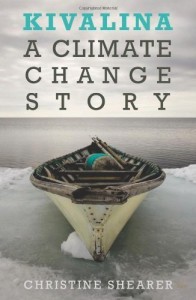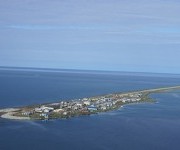The residents of Kivalina, Alaska, are feeling mighty vulnerable these days.Photo: USCG PressIn Christine Shearer’s new book Kivalina: A Climate Change Story, global warming moves off the pages of science and into the lives of everyday people.
Jammed into a narrow island on the northwest coast of Alaska, the town of Kivalina is home to 400 souls, with evidence of occupation extending back over a millennium. Due to the melting of sea ice, the island now gets a regular beating from ocean storms and is rapidly disappearing. The logical solution of relocating to the mainland is estimated to cost more than the town can afford, and despite warnings in 2004 and 2009 [PDFs] by the U.S. Government Accountability Office that Kivalina, like 30 other coastal communities in Alaska, faces serious danger, there’s still no viable plan that residents can count on.
With the clock ticking, the cold Chukchi Sea seems to loom over every interaction, every conversation. Residents describe nightmares of being swept out to sea. Even more vivid are the details of actual events, such as the 2007 storm during which people struggled in pitch darkness to reassure crying children and move belongings as the sea grabbed chunks of land. Between such moments of panic, life is filled with a numbing pattern of rising hopes for relocation followed by bureaucratic dead ends. Ironically, the one agency that would seem the logical source of relief — FEMA — can only get involved after disaster strikes.
In the course of her story, Shearer takes detours off the island to explore the legal and policy context of the dilemma. The shifts from white-knuckled narrative to detached analysis are both a strength and a weakness of the book. Having engaged the reader in the emotions experienced on the island, it almost feels like a betrayal to digress into politics, law, and history. But Shearer, a post-doctoral fellow at U.C.-Santa Barbara whose interests encompass corporate PR and energy policy (including research on the coal industry for CoalSwarm, the informational website that I coordinate), has a wider agenda: identifying the deliberate decisions and decision-makers within powerful institutions that have helped bring about the destruction of Kivalina. That agenda is shared by the residents of the island, who went to court in 2008 [PDF] not merely to secure justice but for the practical objective of funding their relocation.
 Kivalina’s audacious suit against 24 major oil, coal, and power companies would not have been conceivable without lawyer Luke Cole, cofounder of the Center on Race, Poverty & the Environment. Cole had previously spent six years working with Kivalina on a water pollution lawsuit against a nearby gold mine, ultimately winning a settlement. Looking for ways to help Kivalina solve its relocation dilemma, he noticed significant parallels to legal claims filed by victims of tobacco and asbestos. Joined by the Native American Rights Fund and citing key precedents, Cole filed suit in 2008 on behalf of Kivalina, charging the companies with a “coordinated conspiracy” to deceive the public. The suit was immediately attacked by pro-corporate legal foundations, one of which labeled it “the most dangerous litigation in America” [PDF].
Kivalina’s audacious suit against 24 major oil, coal, and power companies would not have been conceivable without lawyer Luke Cole, cofounder of the Center on Race, Poverty & the Environment. Cole had previously spent six years working with Kivalina on a water pollution lawsuit against a nearby gold mine, ultimately winning a settlement. Looking for ways to help Kivalina solve its relocation dilemma, he noticed significant parallels to legal claims filed by victims of tobacco and asbestos. Joined by the Native American Rights Fund and citing key precedents, Cole filed suit in 2008 on behalf of Kivalina, charging the companies with a “coordinated conspiracy” to deceive the public. The suit was immediately attacked by pro-corporate legal foundations, one of which labeled it “the most dangerous litigation in America” [PDF].
Of course, no matter how strong the precedents, the odds for a village of 400 to prevail against the world’s largest industry — and biggest corporate legal firms — can only be described as long. Yet broad lawsuits based on common law “nuisance” principles have won in the past in cases where intentional corporate deception has been established. So far, despite ups and downs, the Kivalina suit remains in play, most recently buoyed by the Supreme Court’s June 2011 decision in AEP v. Connecticut, which expressly affirmed that common law tort suits at the state level were not preempted by the EPA’s federal authority under the Clean Air Act.
Even if Kivalina succeeds in financing its relocation, the future of the community is by no means assured. Shearer recounts how a contractor working on the relocation problem, URS Corporation, proposed an inland site that horrified residents — too cold, too windy, too removed from the coast — and has yet to consider their objections. A story with eerie resonance is that of the Fort Berthold Reservation in North Dakota, where in 1947 the U.S. Army Corps of Engineers began what amounted to a cruel, involuntary experiment on one of the most prosperous Native American groups in the United States at that time, the Three Affiliated Tribes (Mandan, Hidatsa, and Arikara) inhabiting nine towns along the Missouri River. Here, ironically citing the purpose of flood control, the Corps of Engineers constructed the world’s fifth largest earth-filled dam, inundating hundreds of thousands of acres of rich bottomlands that had supported a thriving farming and ranching economy for the Three Affiliated Tribes, including the direct descendants of the villagers who befriended and sheltered the Lewis and Clark expedition during the winter of 1805.
Relocation from fertile, sheltered bottomlands to the windswept high grounds of the prairie proved devastating. Armed with jacks and sledgehammers, Corps of Engineers workers would appear without warning to transport houses. Deprived of its agricultural base, the reservation economy collapsed; decades later, survivors of the inundation still struggled with poverty and fragmentation. As vividly described in Paul VanDevelder’s classic account Coyote Warrior and in J. Carlos Peinado’s 2006 documentary Waterbuster, the trauma continues to reverberate.
What makes both Kivalina and Fort Berthold different from the typical “victims of civilization” tragedy is the creative pushback, particularly attempts to break new legal ground and the determination to pull the long thread of culpability to a definite ending point. In a world where accountability so easily disappears into large bureaucracies and corporations, finding justice requires extraordinary effort. In the Fort Berthold story, credit goes to attorney Raymond Cross, the son of tribal chief Martin Cross, who originally led the unsuccessful fight against Garrison Dam. Regarded as one of the most innovative attorneys of his generation, Raymond Cross eventually broke new ground for tribal sovereignty, successfully arguing the Wold II case before the U.S. Supreme Court. In addition, Cross engineered congressional legislation that finally secured compensation for the Three Affiliated Tr
ibes in 1998. By then, of course, a half century had been lost.
Tragically, the legal dynamo behind the Kivalina lawsuit, attorney Luke Cole, was killed in a car accident in 2009. Cole’s work is carried on by the Center on Race, Poverty, and the Environment and its allies. One can only hope that, unlike the experience of the Three Affiliated Tribes in North Dakota, who suffered in isolation, the solidarity of the climate movement with the residents of Kivalina somehow helps produce a better outcome.



